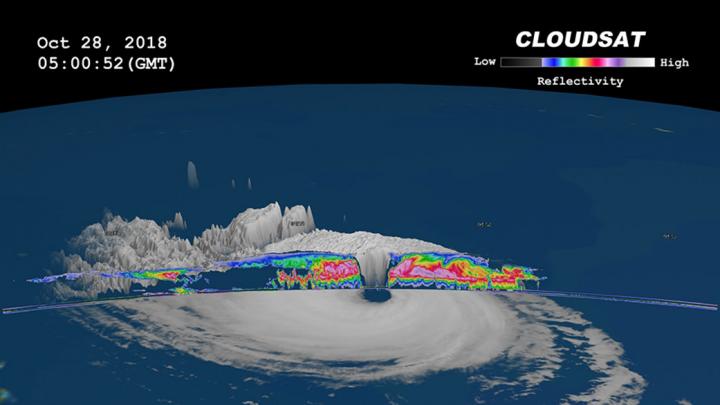NASA's CloudSat gets a slice of Typhoon Yutu's eye

CloudSat flew over the eye of Typhoon Yutu on Oct. 28, 2018 at 12:58 a.m. EDT (0458 UTC) as the storm was approaching the Philippines in the Western North Pacific. Yutu revealed the cirrus free eye with an outward sloping eyewall, a feature typically found in intense tropical systems. Intense areas of convection with moderate to heavy rainfall (deep red and pink colors), cloud-free areas (moats) underneath the northern portion of the cirrus canopy and cloud top height's estimated at 14 kilometers. Lower values of reflectivity (areas of green and blue) denote smaller ice and water particle sizes typically located at top of the system (in the anvil area). Credit: Colorado State/Natalie Tourville Credit: Colorado State/Natalie Tourville
CloudSat flew over the eye of Typhoon Yutu on October 28, 2018 at 12:58 a.m. EDT (0458 UTC) as the storm was approaching the Philippines in the Western North Pacific. At the time of the CloudSat overpass, Typhoon Yutu was beginning a period of weakening as the storm was moving info less favorable atmospheric conditions (lower sea surface temperatures).
Typhoon Yutu contained estimated sustained winds of 120 knots (138 mph) with a minimum pressure of 933 millibars (the equivalent of a Category 4 strength storm). Typhoon Yutu left a trail of destruction through Saipan, Tinian and the Mariana Islands on October 24 and 25, 2018 as a Super Typhoon (category 5 strength storm).
Natalie Tourville of Colorado State University who produced the images, said “CloudSat's 94 GHz cloud profiling radar (CPR) passed directly over the eye of Typhoon Yutu revealing the cirrus free eye with an outward sloping eyewall, a feature typically found in intense tropical systems. The southern portion of the eyewall appears more disorganized as the thicker cloud tops are starting to disintegrate from the top down.
The CloudSat overpass reveals the inner details beneath the storms cloud tops. Intense areas of convection with moderate to heavy rainfall, cloud-free areas (moats) underneath the northern portion of the cirrus canopy and cloud top height's estimated at 14 kilometers (8.7 miles).
Lower values of reflectivity denote smaller ice and water particle sizes typically located at top of the system (in the anvil area).
The CloudSat CPR signal attenuates in heavy rainfall when cloud droplets become larger than 3 millimeters (.11 inch) which dampen the strength of the CPR signal. This is evident by the lack of signal typically occurring beneath the melting level when frozen particles transform into liquid.”
On Oct. 31 at 5 a.m. EDT (0900 UTC) Yutu had weakened to a tropical storm with maximum sustained winds near 45 knots (52 mph/83 kph). Tropical storm Yutu was centered near 18.1 degrees north latitude and 117.5 degrees east longitude, about 291 nautical miles northwest of Manila, Philippines.
As Yutu moves toward China, Hong Kong has posted Stand-by signal #1. The Joint Typhoon Warning Center expects Yutu to re-strengthen as it moves north. The storm is forecast to dissipate off the Chinese mainland, east of Hong Kong.
Media Contact
More Information:
https://blogs.nasa.gov/hurricanes/tag/yutu-2018/All latest news from the category: Earth Sciences
Earth Sciences (also referred to as Geosciences), which deals with basic issues surrounding our planet, plays a vital role in the area of energy and raw materials supply.
Earth Sciences comprises subjects such as geology, geography, geological informatics, paleontology, mineralogy, petrography, crystallography, geophysics, geodesy, glaciology, cartography, photogrammetry, meteorology and seismology, early-warning systems, earthquake research and polar research.
Newest articles

First-of-its-kind study uses remote sensing to monitor plastic debris in rivers and lakes
Remote sensing creates a cost-effective solution to monitoring plastic pollution. A first-of-its-kind study from researchers at the University of Minnesota Twin Cities shows how remote sensing can help monitor and…

Laser-based artificial neuron mimics nerve cell functions at lightning speed
With a processing speed a billion times faster than nature, chip-based laser neuron could help advance AI tasks such as pattern recognition and sequence prediction. Researchers have developed a laser-based…

Optimising the processing of plastic waste
Just one look in the yellow bin reveals a colourful jumble of different types of plastic. However, the purer and more uniform plastic waste is, the easier it is to…



